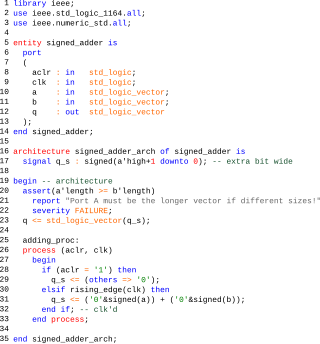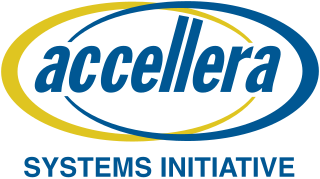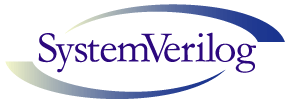Related Research Articles
Signal-to-noise and distortion ratio (SINAD) is a measure of the quality of a signal from a communications device, often defined as

The VHSIC Hardware Description Language (VHDL) is a hardware description language (HDL) that can model the behavior and structure of digital systems at multiple levels of abstraction, ranging from the system level down to that of logic gates, for design entry, documentation, and verification purposes. Since 1987, VHDL has been standardized by the Institute of Electrical and Electronics Engineers (IEEE) as IEEE Std 1076; the latest version of which is IEEE Std 1076-2019. To model analog and mixed-signal systems, an IEEE-standardized HDL based on VHDL called VHDL-AMS has been developed.
Verilog, standardized as IEEE 1364, is a hardware description language (HDL) used to model electronic systems. It is most commonly used in the design and verification of digital circuits at the register-transfer level of abstraction. It is also used in the verification of analog circuits and mixed-signal circuits, as well as in the design of genetic circuits. In 2009, the Verilog standard was merged into the SystemVerilog standard, creating IEEE Standard 1800-2009. Since then, Verilog is officially part of the SystemVerilog language. The current version is IEEE standard 1800-2017.
Standard Delay Format (SDF) is an IEEE standard for the representation and interpretation of timing data for use at any stage of an electronic design process. It finds wide applicability in design flows, and forms an efficient bridge between dynamic timing verification and static timing analysis.
The IEEE 1164 standard is a technical standard published by the IEEE in 1993. It describes the definitions of logic values to be used in electronic design automation, for the VHDL hardware description language. It was sponsored by the Design Automation Standards Committee of the Institute of Electrical and Electronics Engineers (IEEE). The standardization effort was based on the donation of the Synopsys MVL-9 type declaration.
Property Specification Language (PSL) is a temporal logic extending linear temporal logic with a range of operators for both ease of expression and enhancement of expressive power. PSL makes an extensive use of regular expressions and syntactic sugaring. It is widely used in the hardware design and verification industry, where formal verification tools and/or logic simulation tools are used to prove or refute that a given PSL formula holds on a given design.

Accellera Systems Initiative (Accellera) is a standards organization that supports a mix of user and vendor standards and open interfaces development in the area of electronic design automation (EDA) and integrated circuit (IC) design and manufacturing. It is less constrained than the Institute of Electrical and Electronics Engineers (IEEE) and is therefore the starting place for many standards. Once mature and adopted by the broader community, the standards are usually transferred to the IEEE.
SystemC is a set of C++ classes and macros which provide an event-driven simulation interface. These facilities enable a designer to simulate concurrent processes, each described using plain C++ syntax. SystemC processes can communicate in a simulated real-time environment, using signals of all the datatypes offered by C++, some additional ones offered by the SystemC library, as well as user defined. In certain respects, SystemC deliberately mimics the hardware description languages VHDL and Verilog, but is more aptly described as a system-level modeling language.
IEEE 802.1Q, often referred to as Dot1q, is the networking standard that supports virtual local area networking (VLANs) on an IEEE 802.3 Ethernet network. The standard defines a system of VLAN tagging for Ethernet frames and the accompanying procedures to be used by bridges and switches in handling such frames. The standard also contains provisions for a quality-of-service prioritization scheme commonly known as IEEE 802.1p and defines the Generic Attribute Registration Protocol.
A test plan is a document detailing the objectives, resources, and processes for a specific test for a software or hardware product. The plan typically contains a detailed understanding of the eventual workflow.
IEEE P1363 is an Institute of Electrical and Electronics Engineers (IEEE) standardization project for public-key cryptography. It includes specifications for:
Standard Parasitic Exchange Format (SPEF) is an IEEE standard for representing parasitic data of wires in a chip in ASCII format. Non-ideal wires have parasitic resistance and capacitance that are captured by SPEF. These wires also have inductance that is not included in SPEF. SPEF is used for delay calculation and ensuring signal integrity of a chip which eventually determines its speed of operation.

SystemVerilog, standardized as IEEE 1800, is a hardware description and hardware verification language used to model, design, simulate, test and implement electronic systems. SystemVerilog is based on Verilog and some extensions, and since 2008, Verilog is now part of the same IEEE standard. It is commonly used in the semiconductor and electronic design industry as an evolution of Verilog.
A software design description is a representation of a software design that is to be used for recording design information, addressing various design concerns, and communicating that information to the design’s stakeholders. An SDD usually accompanies an architecture diagram with pointers to detailed feature specifications of smaller pieces of the design. Practically, the description is required to coordinate a large team under a single vision, needs to be a stable reference, and outline all parts of the software and how they will work.
The Si2 Common Power Format, or CPF is a file format for specifying power-saving techniques early in the design process. In the design of integrated circuits, saving power is a primary goal, and designers are forced to use sophisticated techniques such as clock gating, multi-voltage logic, and turning off the power entirely to inactive blocks. These techniques require a consistent implementation in the design steps of logic design, implementation, and verification. For example, if multiple different power supplies are used, then logic synthesis must insert level shifters, place and route must deal with them correctly, and other tools such as static timing analysis and formal verification must understand these components. As power became an increasingly pressing concern, each tool independently added the features needed. Although this made it possible to build low power flows, it was difficult and error prone since the same information needed to be specified several times, in several formats, to many different tools. CPF was created as a common format that many tools can use to specify power-specific data, so that power intent only need be entered once and can be used consistently by all tools. The aim of CPF is to support an automated, power-aware design infrastructure.
IP-XACT is an XML format that defines and describes individual, re-usable electronic circuit designs to facilitate their use in creating integrated circuits. IP-XACT was created by the SPIRIT Consortium as a standard to enable automated configuration and integration through tools.
The Design Automation Standards Committee (DASC) is a subgroup of interested individuals members of the Institute of Electrical and Electronics Engineers (IEEE) Computer Society and Standards Association. It oversees IEEE Standards that are related to computer-aided design. It is part of the IEEE Computer Society.
High-level verification (HLV), or electronic system-level (ESL) verification, is the task to verify ESL designs at high abstraction level, i.e., it is the task to verify a model that represents hardware above register-transfer level (RTL) abstract level. For high-level synthesis, HLV is to HLS as functional verification is to logic synthesis.
IEEE 1680 is a family of IEEE sustainability standards dealing with the assessment of environmental performance of electronic products.
Advanced Library Format (ALF), also known as IEEE 1603 or IEC 62265, is an IEEE and IEC standard that describes a data specification language for library elements used in ASIC design applications for integrated circuits. ALF can model behavior, timing, power and noise, hot electron, electromigration, antenna effects, physical abstraction and physical implementation rules of library elements.
References
- ↑ Richard Goering (September 18, 2006). "Accellera rolls power plan". EE Times. Retrieved July 7, 2011.
- ↑ "Documents from Group 'Unified Power Format Technical Committee'". Accellera public groups area. Retrieved July 7, 2011.
- ↑ "Unified Power Format (UPF) Standard Version 1.0" (PDF). Accellera. Retrieved August 7, 2011.
- ↑ Sherry Hampton (May 9, 2007). "P1801 - Standard for Design and Verification of Low Power Integrated Circuits" (PDF). IEEE Standards Association Standards Board. Retrieved July 7, 2011.
- 1 2 "P1801 Low Power Study Group By Thread". Hypermail archive. Retrieved July 7, 2011.
- ↑ "IEEE P1801 - Unified Power Format Standard". Accelera Organization Inc. Retrieved July 7, 2011.
- ↑ UPF: Standard for Design and Verification of Low Power Integrated Circuits (March 27, 2009). 1801-2009 - IEEE Standard for Design and Verification of Low Power Integrated Circuits. IEEE Standards Association. doi:10.1109/IEEESTD.2009.4809845. ISBN 978-0-7381-5930-0 . Retrieved July 6, 2011.
- ↑ Nic Mokhoff (March 20, 2009). "IEEE approves low-power design spec". EE Times. Retrieved July 7, 2011.
- ↑ "IEEE 1801-2009 ― Unified Power Format (UPF)". Synopsys. Retrieved July 7, 2011.
- 1801-2009 — IEEE Standard for Design and Verification of Low Power Integrated Circuits. 2009. doi:10.1109/IEEESTD.2009.4809845. ISBN 978-0-7381-5929-4.
- 1801-2013 — IEEE Standard for Design and Verification of Low-Power Integrated Circuits. 2013. doi:10.1109/IEEESTD.2013.6521327. ISBN 978-0-7381-8281-0.
- 1801-2015 — IEEE Standard for Design and Verification of Low-Power, Energy-Aware Electronic Systems. 2016. doi:10.1109/IEEESTD.2016.7445797. ISBN 978-1-5044-0105-0.
- 1801-2018 — IEEE Standard for Design and Verification of Low-Power, Energy-Aware Electronic Systems. 2019. doi:10.1109/IEEESTD.2019.8686430. ISBN 978-1-5044-5258-8.